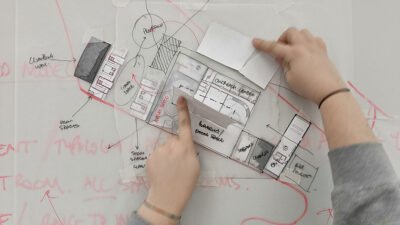Becoming an architect is a dream for many. It’s a profession that combines creativity with practicality, allowing individuals to design buildings that are both aesthetically pleasing and structurally sound. In Wisconsin, the journey to becoming an architect involves a combination of education, experience, and examination. This article provides a step-by-step guide to help you understand the process and what you need to do to achieve your goal.
Step 1: Educational Requirements
Embarking on the journey to become an architect in Wisconsin begins with a solid educational foundation. This crucial first step involves enrolling in and completing an architecture degree from a program accredited by the National Architectural Accrediting Board (NAAB). Accreditation by the NAAB ensures that the curriculum meets national standards for architectural education, equipping students with the necessary knowledge and skills.
- Selecting the Right Institution: Wisconsin offers excellent options for aspiring architects, with universities like the University of Wisconsin-Milwaukee and the University of Wisconsin-Madison standing out for their reputable programs. These institutions not only provide the academic rigor required for a robust architectural education but also offer unique opportunities for hands-on learning and exposure to real-world projects;
- Curriculum and Focus Areas: Programs typically cover a range of subjects including design, history of architecture, building science, and technology. They also emphasize developing critical thinking and creative problem-solving skills, which are essential in the field of architecture;
- Practical Experience and Networking: These universities often have strong connections with the architectural community in Wisconsin, offering students opportunities for internships and networking. Engaging with practicing architects and participating in real-world projects during one’s studies can provide invaluable experience and insights into the profession;
- Beyond Undergraduate Studies: While a Bachelor of Architecture (B.Arch) degree is a common path, some students may choose to pursue a Master of Architecture (M.Arch) degree, especially if their undergraduate degree was in a different field. Graduate programs offer more specialized knowledge and can be a pathway for those looking to deepen their expertise or focus on a specific aspect of architecture;
- Preparing for the Future: A degree from a NAAB-accredited program is not only a prerequisite for licensure but also prepares graduates for the diverse challenges they will face in their professional careers. Students learn to balance aesthetic considerations with practical requirements, understanding the environmental, social, and economic impact of architecture;
Obtaining the right education from a NAAB-accredited institution is a fundamental and critical step for anyone aspiring to become an architect in Wisconsin. It lays the groundwork for future professional development, equipping aspiring architects with the skills, knowledge, and network needed to succeed in this competitive and rewarding field.
Bachelor of Architecture (B.Arch)
- A five-year professional degree;
- Focuses on design, building technology, professional practice, and liberal arts.
Master of Architecture (M.Arch)
- For students with a pre-professional undergraduate degree in another field;
- Typically takes 2-3 years to complete.
Step 2: Internship and Experience
Gaining practical experience is a critical step in the journey to becoming a licensed architect in Wisconsin. After obtaining a degree, the immediate focus shifts to the Architectural Experience Program (AXP), a structured program that ensures aspiring architects acquire the hands-on experience necessary for a successful career.
- Architectural Experience Program (AXP): Administered by the National Council of Architectural Registration Boards (NCARB), the AXP is designed to provide comprehensive training in the field of architecture. The program requires completion of 3,740 hours of work experience, offering a balanced blend of learning and practical application;
- Supervised Experience: A key aspect of the AXP is that all experience must be gained under the supervision of a licensed architect. This mentorship is invaluable, as it allows emerging architects to learn from experienced professionals, gaining insights that are not always available in the classroom;
- Diverse Practice Areas: The required hours are spread across six core practice areas. These include design and construction documentation, project management, and site analysis, among others. This diversity ensures that aspiring architects develop a well-rounded skill set, preparing them for the various challenges they will encounter in their professional lives;
- Real-World Application: The AXP serves as a bridge between academic theory and real-world architectural practice. It provides a safe environment for aspiring architects to apply their knowledge, make mistakes, and learn from them under the guidance of seasoned professionals;
- Progress Tracking: NCARB offers tools to track progress through the AXP, ensuring that candidates complete all required hours and experience areas. This structured approach helps maintain focus and momentum throughout the program;
- Preparing for Licensure: Completing the AXP is not just about fulfilling a requirement; it’s about gaining the confidence and competence to handle the responsibilities of a licensed architect. This experience is crucial for passing the Architect Registration Examination (ARE) and for future professional practice.
The AXP is a pivotal phase in the career development of architects in Wisconsin. It provides the practical experience and skills necessary to transition from academic learning to professional practice, laying a solid foundation for a successful career in architecture.
Step 3: Examination
After completing the requisite education and practical experience, aspiring architects in Wisconsin must confront the Architect Registration Examination (ARE), a pivotal and challenging step in their professional journey. The ARE, a comprehensive and multi-part examination, is meticulously designed to evaluate a candidate’s proficiency in various critical areas of architecture.
This examination, administered by the National Council of Architectural Registration Boards (NCARB), serves as a rigorous assessment of a candidate’s knowledge and skills. It spans a wide range of topics integral to the architectural profession, including project management, site planning, and building design. Each component of the ARE is crafted to test the depth and breadth of understanding that an aspiring architect should possess, ensuring they are well-equipped to handle the complexities of the field.
The process of preparing for and passing the ARE is demanding. Candidates typically invest significant time in studying architectural principles, laws, and standards, and in developing a comprehensive understanding of practical applications in architecture. Many engage in intensive study regimes, often participating in study groups and utilizing various resources and practice materials offered by NCARB and other architectural organizations. Passing the ARE is more than just an academic achievement; it’s a demonstration of a candidate’s readiness to contribute effectively and responsibly to the architectural profession. It is a critical gateway, ensuring that only those with the required level of expertise and competence earn the privilege of licensure. This rigorous process plays a vital role in upholding the standards of the architectural profession, safeguarding public health, safety, and welfare in all aspects of the built environment.
Ultimately, the ARE marks a significant transition from theoretical learning and supervised practice to independent professional practice. Success in this examination signifies that an individual is fully prepared to embrace the responsibilities and creative challenges of being a licensed architect, ready to make a meaningful impact in the field of architecture.
Step 4: Licensure
Upon successfully passing the Architect Registration Examination (ARE), the journey to becoming a licensed architect in Wisconsin reaches a pivotal stage. This achievement brings you to the threshold of professional practice, but one final administrative step remains: applying for your architectural license through the Wisconsin Department of Safety and Professional Services. This application process is a formal procedure that verifies your eligibility to practice as a licensed architect in the state. It involves the submission of several key documents: your academic transcripts, a record of your completed Architectural Experience Program (AXP), and your ARE results. These documents collectively serve as proof of your educational background, practical training, and professional competence.
Your academic transcripts provide evidence of your completion of a degree from a National Architectural Accrediting Board (NAAB)-accredited program, affirming your foundational knowledge in architecture. The AXP record is a testament to your hands-on experience in the field, under the supervision of licensed professionals. Finally, your ARE results demonstrate your proficiency across a range of critical architectural skills and knowledge areas.
Once these documents are submitted, the Wisconsin Department of Safety and Professional Services will conduct a thorough review of your application. This process ensures that all licensure candidates meet the high standards set for architectural practice in Wisconsin. Upon approval of your application, you will be granted your license, officially recognizing you as a licensed architect in the state. Receiving your license is more than just a formal acknowledgment; it’s a moment of significant professional achievement. It marks the beginning of a new chapter in your career where you can independently practice architecture, contribute to the built environment, and bring your architectural visions to life. As a licensed architect in Wisconsin, you are now part of a community of professionals committed to designing safe, functional, and aesthetically pleasing spaces, shaping the state’s architectural landscape for future generations.
Continuous Learning
Even after becoming a licensed architect, continuing education is essential. Wisconsin requires architects to complete 24 hours of continuing education every two years to maintain their license. These courses keep you updated on new technologies, trends, and regulations in the field.
Career Opportunities and Outlook
As a licensed architect in Wisconsin, the scope of your career can be both diverse and rewarding. The state offers a wide range of opportunities in various sectors, allowing architects to explore and contribute to different facets of the built environment. This versatility is a significant advantage of the profession, providing flexibility and the chance to work on a variety of projects.
- Residential Sector: In residential architecture, you can engage in designing homes that range from high-density urban living spaces to suburban houses. This sector often allows architects to work closely with clients, tailoring designs to meet specific needs and preferences;
- Commercial and Corporate Projects: The commercial sector offers opportunities to design office buildings, retail spaces, and other commercial structures. These projects can be complex and challenging, requiring innovative solutions to accommodate the needs of businesses and consumers;
- Government and Public Works: Working on government projects can include designing public buildings like schools, hospitals, and government offices. These projects often have a significant impact on communities, offering a sense of fulfillment and public service;
- Growth and Trends: The architectural field in Wisconsin is influenced by economic trends and construction activities. According to the U.S. Bureau of Labor Statistics, the employment of architects is projected to grow by about 4 percent from 2021 to 2031. This growth rate mirrors the average for all occupations, indicating steady demand for architectural services;
- Economic Indicators: The demand for architects is often linked to the broader economy, with growth in sectors like real estate, retail, and public infrastructure directly affecting the need for architectural services. Wisconsin’s diverse economy provides a stable environment for architects, with opportunities arising in both urban and rural areas;
- Future Opportunities: Emerging trends, such as sustainable and green building practices, are also creating new avenues for architects. As the industry continues to evolve, there is a growing need for professionals who can incorporate environmental considerations into their designs.
Being a licensed architect in Wisconsin opens up a world of possibilities. Whether it’s designing a family’s dream home, creating a state-of-the-art office complex, or contributing to public infrastructure, the opportunities are as varied as they are rewarding. With a steady market and evolving industry trends, architects in Wisconsin can look forward to a dynamic and fulfilling career.
Challenges and Rewards
Becoming an architect is challenging but rewarding. It requires a strong commitment to education and continuous learning. Architects in Wisconsin have the opportunity to shape the environment and contribute to the community’s well-being through sustainable and innovative designs.
Conclusion
The path to becoming an architect in Wisconsin is a testament to the power of dedication, hard work, and passion. It’s a journey that goes beyond academic achievement, encompassing a deep commitment to shaping environments and communities through thoughtful design and innovation. Aspiring architects who embark on this path are not just building careers; they are paving the way to make significant contributions to the built environment and society.
- Comprehensive Preparation: The journey involves a comprehensive preparation process, starting with obtaining a robust education from NAAB-accredited institutions. This education lays the foundation for understanding the complexities of architectural design, technology, and theory;
- Hands-on Experience: Gaining real-world experience through the Architectural Experience Program (AXP) is crucial. This stage is where theoretical knowledge is applied in practical settings, offering insights into the realities of architectural work and preparing you for the diverse challenges you will face as a professional;
- Achieving Licensure: Successfully passing the Architect Registration Examination (ARE) and achieving licensure is a milestone that signifies your readiness to practice as a professional architect. It is an affirmation of your skills, knowledge, and adherence to the ethical and professional standards of the field;
- Impact and Influence: As an architect in Wisconsin, you have the unique opportunity to influence and shape the physical spaces where people live, work, and interact. Your designs can contribute to the cultural, social, and environmental fabric of communities, creating a lasting impact that extends far beyond the structures themselves;
- Continual Growth: The field of architecture is dynamic, requiring continual learning and adaptation to new technologies, materials, and sustainability practices. This aspect of the profession ensures a career that is not only fulfilling but also constantly evolving, offering endless opportunities for creativity and innovation.
In essence, becoming an architect in Wisconsin is more than just a professional choice; it’s a commitment to a lifestyle of learning, creativity, and community service. It’s a career that offers the satisfaction of seeing your visions come to life, enhancing the beauty and functionality of spaces, and positively impacting the lives of those who interact with your creations.











